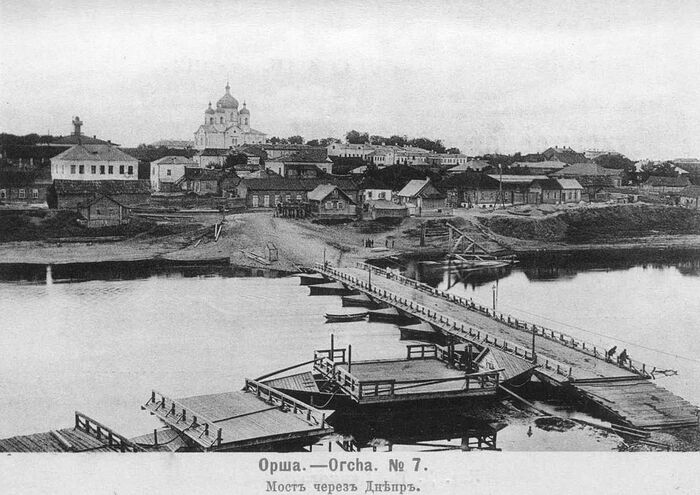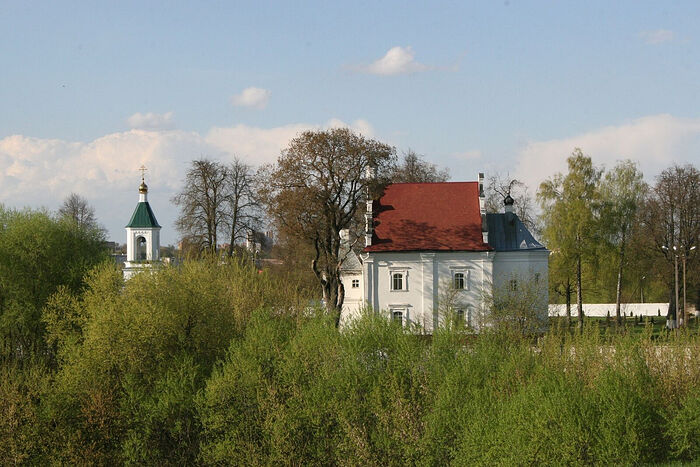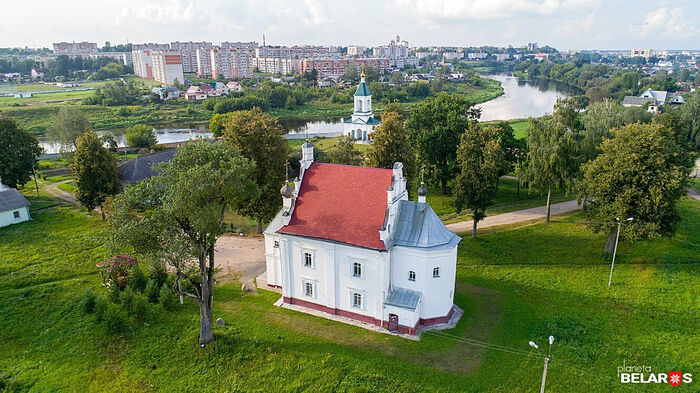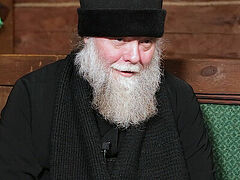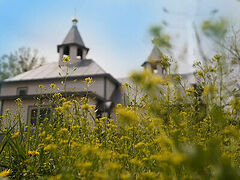In 2023, the Holy Theophany-Kuteino Monastery celebrates its 400th anniversary. The Belarusian city of Orsha held solemn Divine services, cross processions, and cultural events throughout the month of September in celebration of the monastic habitation founded there in 1623 in honor of the Orsha Icon of the Theotokos. What is the history, what is the modern life of this ancient monastery—the sole Belarusian lavra?
There is the great lavra of the holy Theophany
of our Lord God and Savior Jesus Christ,
called Kuteino, near the glorious city of Orsha:
which was the fount and beginning of the monastic life
in all White Russia and in Lithuania…
Patriarch Nikon (Minin)
Near the glorious city of Orsha
Time is like a river that almost imperceptibly but steadily carries its waters into an unknown tomorrow. And the Dnieper, on the banks of which arose the ancient city of Orsha, slowly flows to the faraway Black Sea, just as it did nearly nine and a half centuries ago. And the city, first mentioned in the Tale of Bygone Years around 1067, has endured many historical storms and hardships. The wars of the Grand Duchy of Lithuania, later the Polish-Lithuanian Commonwealth, and then of the Russian Empire considerably changed the city’s appearance. The city has been rebuilt several times. What can be done? History seems to have been merciless to the city.
Looking at old photographs, you can see that Orsha was always, at least until the events of 1917, adorned with a great number of churches. That means there were pious, God-loving people living there. The chronicles report that from the sixteenth to eighteenth centuries, Orsha was a significant religious center. Later documents, from 1909, show that at that time there were seven Orthodox churches, two Catholic churches, and thirteen prayer houses for 17,000 residents.
The most significant role in the history of Orthodoxy in the Orsha lands was played by the Holy Theophany-Kuteino Monastery. This sole Belarusian lavra was erected in Orsha on the left bank of the Dnieper, where the Kuteinka River flows into it. It’s because of this river that the monastery began to be called Kuteino.
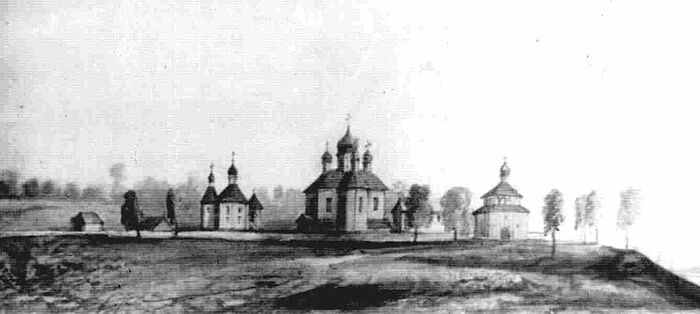 An old image of Kuteino Monastery
An old image of Kuteino Monastery
This monastery united several monasteries that were also called Kuteino: Barkolabovo, Mstislavle, Miorakh, Lukomle…
The flourishing of the monastery lasted for all of about thirty years—from 1623 to 1654. Its decline began during the war between the Polish-Lithuanian Commonwealth and Russia. Many of the inhabitants of Kuteino were forced to leave it then.
The War of 1812 brought even greater devastation to the walls of the holy monastery—Napoleon’s invading troops barbarously plundered and destroyed it. Many of the holy items of the Orsha lavra disappeared without a trace in the fiery vortex of wars and hardships. But the final, most severe wounds were inflicted on the ancient monastery by the hands of the atheists at the beginning of the twentieth century.
These wounds have yet to be healed. And what remains of the former glory and splendor of the Kuteino lavra? After all, here once stood numerous buildings built by the hands of monks and pious craftsmen.
The Lavra
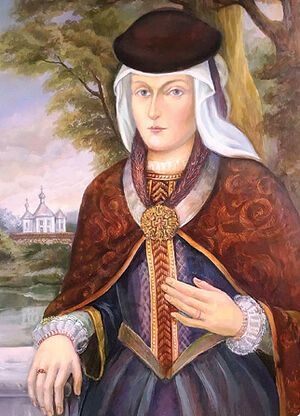 Princess Elena Solomoretskaya The history of the Kuteino lavra is somewhat paradoxical, because its heyday came in the early-seventeenth century—a time when, after the conclusion of the Lublin and Brest Unias, the Orthodox faith was almost entirely eradicated on the territory of the Polish-Lithuanian Commonwealth (of which Orsha was a part at that time).
Princess Elena Solomoretskaya The history of the Kuteino lavra is somewhat paradoxical, because its heyday came in the early-seventeenth century—a time when, after the conclusion of the Lublin and Brest Unias, the Orthodox faith was almost entirely eradicated on the territory of the Polish-Lithuanian Commonwealth (of which Orsha was a part at that time).
Contrary to the strict policy of the Polish-Lithuanian Commonwealth, the Mogilev Theophany brotherhood tried to found a new Orthodox men’s monastery. Hieromonk Joel (Trutsevich), as a member of this brotherhood, appealed to the famous zealot of Orthodoxy, the magnate and nobleman Bogdan Stetkevich with a request to allow a monastery to be built on his land.
Bogdan Stetkevich and his wife, Princess Elena Solomoretskaya, not only allowed the building of a monastery, but also paid for it. The foundation was laid on September 19, 1623, and construction began that same year. One of the first things to be built was the Cathedral of the Theophany of the Lord. However, its construction took an entire twelve years. It was consecrated in 1635 by Metropolitan St. Peter (Mogila) of Kiev.
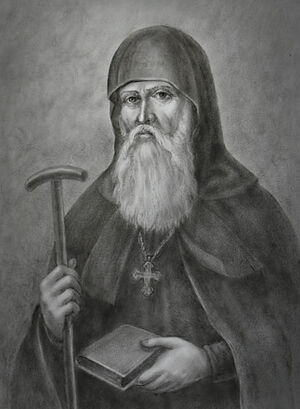 Archimandrite Joel (Trutsevich) The wooden five-domed church rose 130 feet above the Dnieper. Inside, thanks to the efforts of wood carvers, for whom Orsha was so famous, it was adorned with a six-tiered carved iconostasis. The walls of the church were covered with so many paintings that the list of icons in the description of the cathedral takes up four whole pages.
Archimandrite Joel (Trutsevich) The wooden five-domed church rose 130 feet above the Dnieper. Inside, thanks to the efforts of wood carvers, for whom Orsha was so famous, it was adorned with a six-tiered carved iconostasis. The walls of the church were covered with so many paintings that the list of icons in the description of the cathedral takes up four whole pages.
Unfortunately, on June 14, 1891, lightning struck the wooden Holy Theophany Cathedral and it very quickly burned to the ground. Only a stone church in honor of the Holy Life-Giving Trinity has survived to our day.
At the same time as the churches, living quarters and outbuildings were erected on the territory of the monastery. There was a mill with a stone dam on the Kuteinka River, because the monastery owned forested and arable land. The monks maintained a hospital, a school for the children of parishioners, and a guest house for pilgrims. In the first half of the seventeenth century, there were no less than 200 monks living in the monastery, according to the testimony of Metropolitan Peter (Mogila).
Secrets and legends of Kuteino
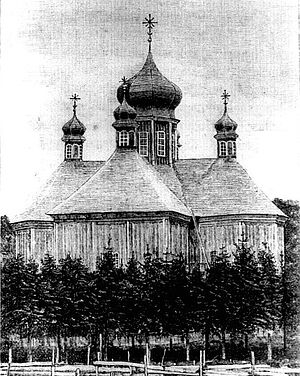 Holy Theophany Cathedral According to experts in the history of the monastery, in 1910, under the smoldering ruins of the Holy Theophany Cathedral, the brethren found an underground church.
Holy Theophany Cathedral According to experts in the history of the monastery, in 1910, under the smoldering ruins of the Holy Theophany Cathedral, the brethren found an underground church.
This church, consecrated in honor of the Resurrection of the Righteous Lazarus, was a small cave room with an area of approximately 115 square feet, with vaulted arched ceilings. There were two rooms next to the church, presumably where they kept the monastery treasury and archive.
There is also information that there’s an underground passage leading north from the church, which has not been fully explored.
The Orsha Icon of the Mother of God
There is a holy icon at Kuteino Monastery that is inextricably bound up with the history of the monastery. There is also very little information about it that has come down to us through the veil of the centuries.
In 1631, the Orsha Icon of the Theotokos miraculous appeared in the city of Orsha, near the Holy Theophany Monastery
The Orsha Icon of the Theotokos miraculous appeared in the city of Orsha in 1631, on the banks of the Kuteinka River, near the Holy Theophany Monastery, and has been considered its patroness ever since.
How it happened is unknown. However, there are two more historical testimonies about her grace-filled help for those who honored her.
According to tradition, the Mother of God appeared in a dream to the Venerable Martyr Athanasius of Brest, who was a resident of Kuteino Monastery in 1627. The Queen of Heaven told the ascetic that he should go to the Kupyatichi Monastery, and foretold his martyric repose. Thus, the celebration of the icon takes place on the feasts of St. Athanasius—August 2 and September 18.
 Orsha Icon of the Theotokos Another resident of Kuteino—the famous publisher Spyridon Sobol—was vouchsafed to receive miraculous support and consolation from the Orsha Icon.
Orsha Icon of the Theotokos Another resident of Kuteino—the famous publisher Spyridon Sobol—was vouchsafed to receive miraculous support and consolation from the Orsha Icon.
Alas, the wonderworking icon itself has disappeared without a trace in the turbulent flow of history. There’s a belief that the icon was carried out to Valdai, to the Iveron Monastery, together with the monastery property during the Time of Troubles.
But one of its copies, painted in the seventeenth century, was kept at the Holy Spirit Cathedral in Minsk. On July 13, 2001, it was gifted to the Vitebsk Diocese and moved to Orsha—first to the old St. Elijah Church (where a convent was founded in 1997), and later, in 2014, to the Holy Trinity Church at the Kuteino Monastery.
Holy Trinity Church
In the 1620s, a wooden church in honor of the Descent of the Holy Spirit was built not far from the Holy Theophany Cathedral. Over time, the wooden church was dismantled, and a stone church was built on its foundation. For a while it was two-storied, but after reconstruction in 1868, it became a one-story church again. Then the church was consecrated in honor of the Life-giving Trinity.
When the monastery was closed in the 1920s, the church was handed over to the Association for Joint Cultivation of Land and was turned into a fertilizer warehouse. All of the frescoes and murals were of course destroyed. The plaster was so saturated with the smell of fertilizers that it had to be completely removed during restoration.
By the early 1980s, the church was severely dilapidated, with a collapsed roof, and the authorities started thinking about demolishing all the dilapidated buildings of the former lavra.
But the church survived. The local citizens, members of the Rusichi Orthodox military-patriotic club, and everyone who was concerned about its fate appealed to the authorities in Orsha, the Orsha District, and Vitebsk Province with a request to transfer the remains of the monastery to them for restoration. Importantly, the restoration began at the hands of those who protected the ancient holy site from destruction.
In 1990, the building of the Holy Trinity Church was returned to the faithful and a parish community was registered. Two years later, by decision of the Synod of the Belarusian Orthodox Church, the Kuteino Monastery was opened. In 1993, after repairs and construction work, the liturgical life resumed in the church.
The restoration of the church was completed in 1994, at the expense of the federal budget. However, the state specialists changed the historical appearance of the church—the building now has pronounced elements of Baroque architecture.
Kuteino is known for its people
Great was the glory of the Kuteino lavra in the early seventeenth century! Thanks to its monks, the light of Orthodoxy and spiritual enlightenment spread from there to all the lands of White Rus’.
And the Orsha craftsmen-artisans glorified the monastery with their skillful hands. A considerable contribution to the cause of spiritual enlightenment was made by the native of Mogilev, the publisher Spyridon Sobol. In 1630, he arrived in Orsha and established a printing house at the Kuteino monastery.
The first books came out the same year: Spiritual Food and a prayer book. And in 1631, the famous Primer was printed. The books were printed in significant print-runs for that time: 200-300 copies each. Over the course of twenty-five years, twenty-three Church and educational texts were published. All of them are recognized as outstanding examples of the printing art of their time.
Together with publishing, Kuteino also developed its own school of engraving. Experts have shown that the engravings published in Kuteino editions were used as models for iconography among Belarusian artists of that time.
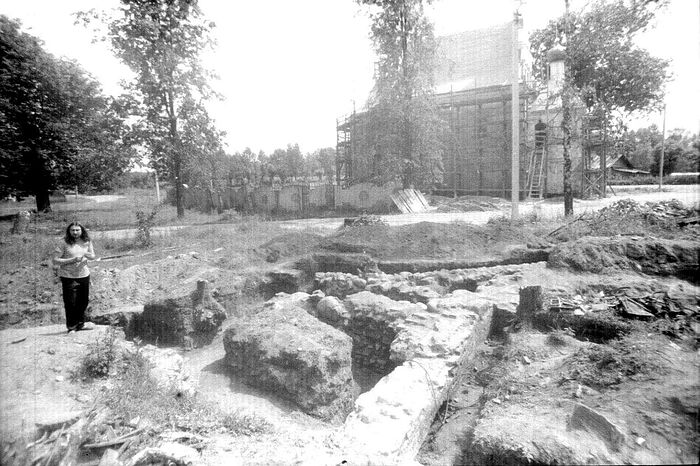 Excavations and restoration of the Holy Trinity Church
Excavations and restoration of the Holy Trinity Church
It was not only the labors of Spyridon Sobol that glorified the Kuteino lavra. Various workshops were established there for skilled wood carvers and potters. This is confirmed by the findings of archaeologists during excavations carried out on the territory of the monastery in the late-1980s–early-1990s.
As a result, a wide variety of materials wound up in the Orsha museum complex, including samples of nineteenth-century ceramics. Scholars believe that all these dishes—a variety of earthenware pots, makitras, and bowls—are of local origin, used in antiquity by the inhabitants of the Kuteino Monastery.
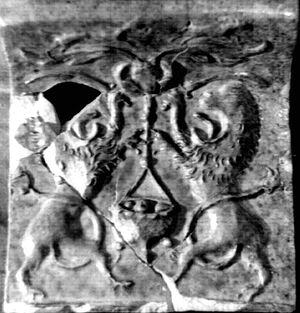 Ceramic tile, Kuteino A number of tile fragments were found—both terracotta and glazed—mostly a green glaze, so-called enameled tiles. There is also a diverse array of ornamentation, including vegetables, with cornflowers and with animals.
Ceramic tile, Kuteino A number of tile fragments were found—both terracotta and glazed—mostly a green glaze, so-called enameled tiles. There is also a diverse array of ornamentation, including vegetables, with cornflowers and with animals.
The most unique find is a carved medallion depicting the Crucifixion and an image of the Mother of God of the Sign.
The fame of the Kuteino wood carvers reached all the way to the primatial See, and the Orsha monastery was personally visited by Patriarch Nikon and Tsar Alexei Fedorovich. After seeing the magnificent carved six-tiered iconostasis of the Holy Theophany Cathedral, the Patriarch asked Abbot Joel (Trutsevich) to send masters to Moscow to create similar works there.
Many centuries have passed since then. The Orsha people of the twentieth century, having found faith, began returning to the churches, but they didn’t find the splendor for which the Orsha churches were renowned in antiquity… So volunteers and lovers of antiquity, such as the artist Viktor Zhuravlev, decided to revive the ancient crafts, and new workshops were opened at the monastery. As the masters recalled:
“The first step in reviving the workshops themselves and the art of wood carving was to gather material. We had to go around to museums and churches and monasteries. Then, with this theoretical material, we began to slowly study books, to deepen our skills and knowledge in carving, and in iconography. Everything started from scratch, from a clean slate.”
Speaking of the distinctive features of the work of the Orsha carvers, Viktor Zhuravlev explained to journalists:
“When the Kuteino masters were working in the seventeenth–eighteenth centuries, they were mainly famous for the so-called Frazhsky, Western style. This carving, completed in large volumes, was more like floral ornamentation, and it was very ‘fancy shmancy,’ as they say now.”
Pilgrim’s view
The modest but homely church of Kuteino Monastery was for many years my place of pilgrimage when I would visit my parents in Orsha. My mother and I have gone to services there many times, and my daughter was baptized there, and we had a good relationship with Igumen Sergei (Konstantinov), who was the abbot of the monastery from 2005 to 2018; especially after I shot a program about the history of the ancient monastery with a crew from Belarusian TV in 2008.
Already 400 years have passed since the founding of Kuteino… Sergei’s mother and father are no longer alive, but the Church of the Holy Trinity is still standing, and prayer still flickers in this place, like a lampada before icons. I remember, fifteen years ago, Fr. Sergei noted in a TV interview:
All our troubles are because the people were separated from the faith for a long time. The time came when children started leading their parents to faith, which never happened before—faith was absorbed from your mother’s milk.
Now many people understand that it’s impossible to live without God. Therefore, we need a revival of the faith, and that’s possible only when there’s some kind of foundation—a guiding, driving force. I think monasticism can be such a force.
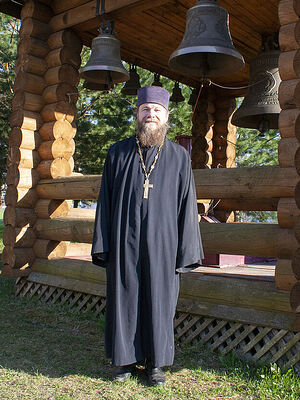 Igumen Nil (Podobed) And in this jubilee year for Kuteino Monastery, Abbot Nil (Podobed), who has been heading the monastic community for the past five years, expressed a similar idea about monasticism. When we met during one of my pilgrimages to Orsha, of course, I couldn’t help but ask him about what had changed in the monastery recently. But a lot has been said and written about it in the Belarusian media, which didn’t miss the landmark date for the monastery.
Igumen Nil (Podobed) And in this jubilee year for Kuteino Monastery, Abbot Nil (Podobed), who has been heading the monastic community for the past five years, expressed a similar idea about monasticism. When we met during one of my pilgrimages to Orsha, of course, I couldn’t help but ask him about what had changed in the monastery recently. But a lot has been said and written about it in the Belarusian media, which didn’t miss the landmark date for the monastery.
In my conversation with the abbot, the thing that impressed me most was when, leaving the conversation about his labors and plans for improving the monastery, Fr. Nil suddenly said, with monastic modesty, that he wasn’t particularly bothered by the fact that the monastery is on a much smaller scale now, quite unlike the former lavra, with just six inhabitants in all. Then he explained: “If we preserve monasticism, it will be the salt of this world, even with few monks.” Indeed, only a little salt is ever really needed—perhaps just a pinch—and it does its job. But if the salt has lost his saltness, wherewith will ye season it? (Mk. 9:50).
Of course, the times have changed over 400 years, and we ourselves and the conditions of our lives have changed. The comfort given by technological progress practically deprives us of the opportunity to imagine what the life of the monks was like in antiquity, what its asceticism was like—both internal and external.
Over the course of thirty years, periodically visiting Kuteino Monastery, I see what external changes are taking place on the territory. This modest monastic home is developing slowly. However, a lot has been done during the abbacy of Fr. Sergei and Fr. Nil. A stone bell tower was erected on the site of the one that was destroyed in the twentieth century. The carved iconostasis for the Holy Trinity Church was completed, and in July 2022, Bishop Euseby of Druts, vicar of the Vitebsk Diocese, celebrated the rite of the Great Consecration for it. In a partially preserved building of the seventeenth century, rooms were built for the celebration of the Sacrament of Baptism, a museum exposition, and a conference hall. The monastery runs a Sunday School and a library.
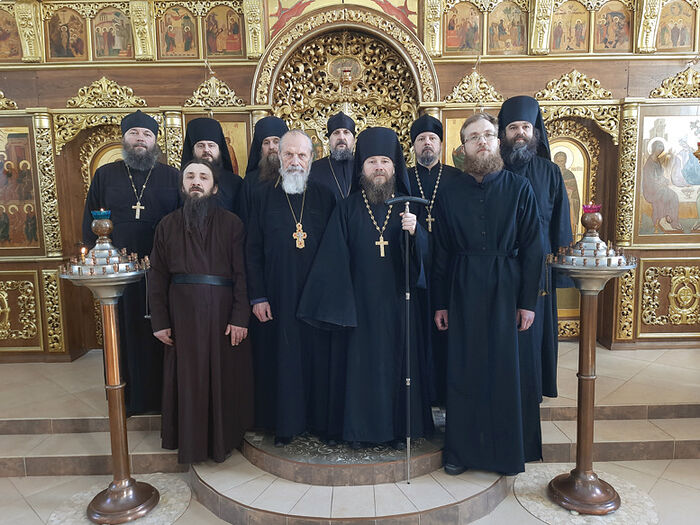 Abbot Nil with the brethren, spiritual father, and clergy of the monastery, 2023
Abbot Nil with the brethren, spiritual father, and clergy of the monastery, 2023
But the most important thing is still that which is invisible to the eye but felt by the heart—here the services are served daily; here incessant prayer burns; here live people who have chosen the path of the ascetic, monastic life. And I really want to believe that despite all the storms and temptations of our world, the salt of spiritual work will not lose its power and will not run low in this ancient, prayer-filled place—not now, not tomorrow, not a hundred years from now.

